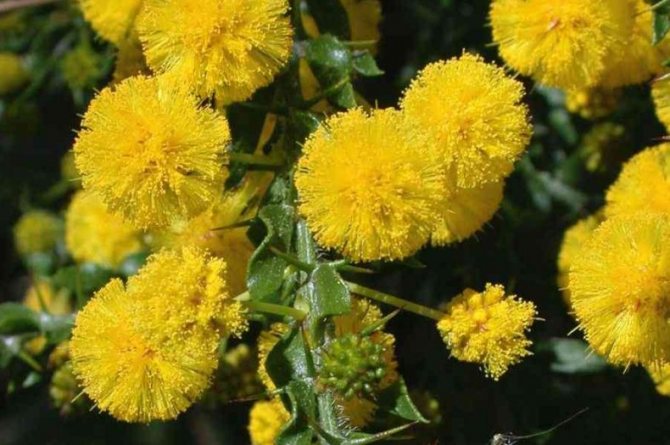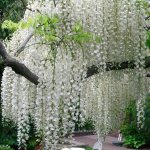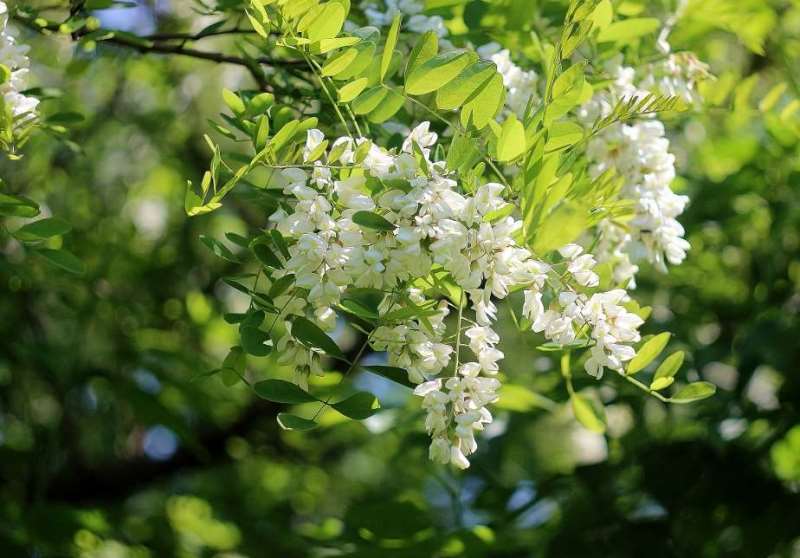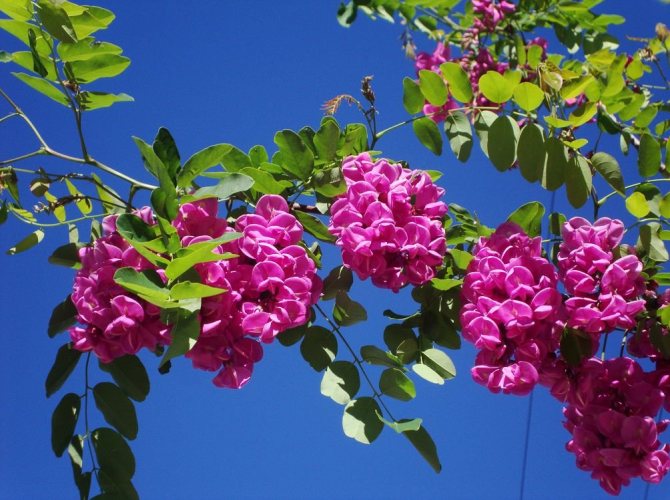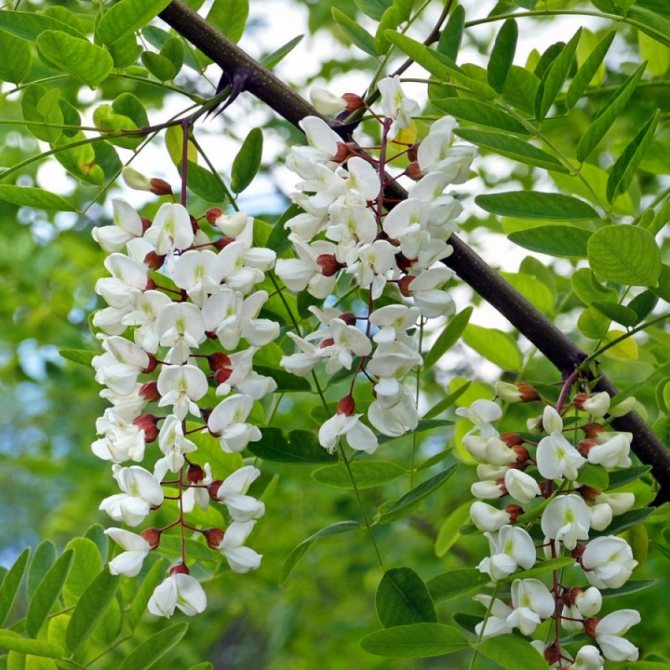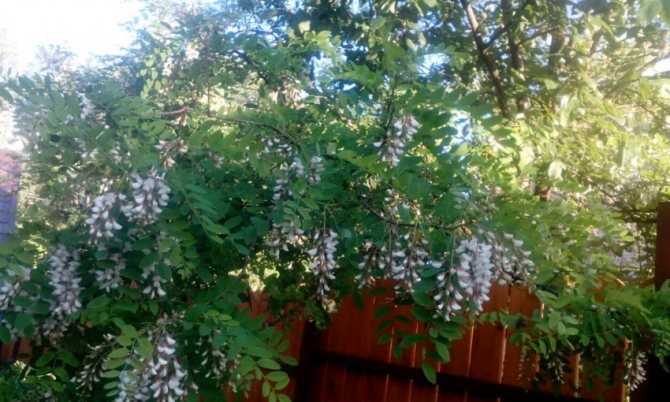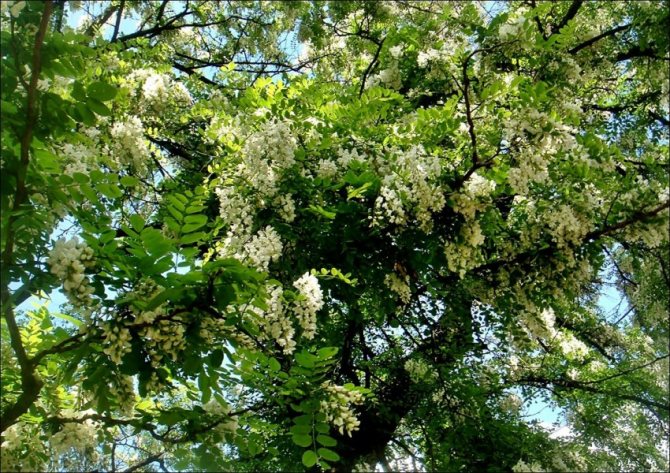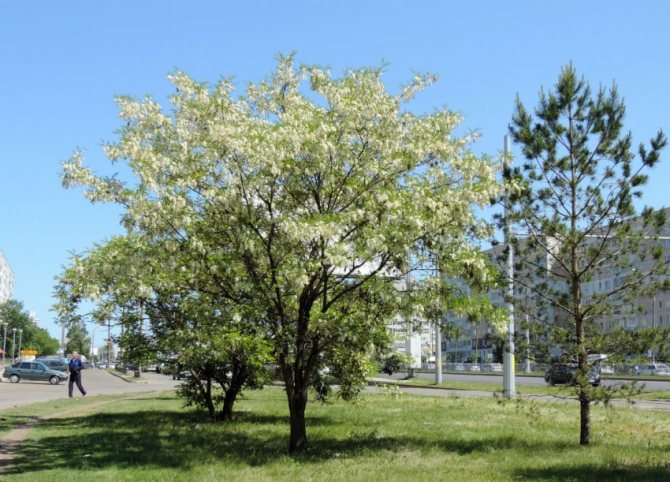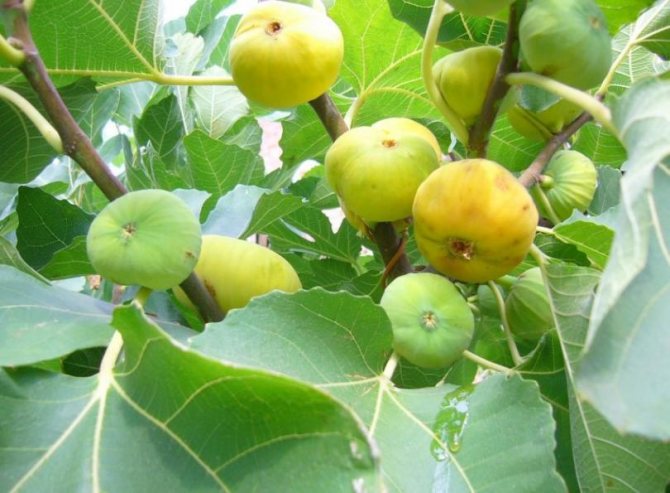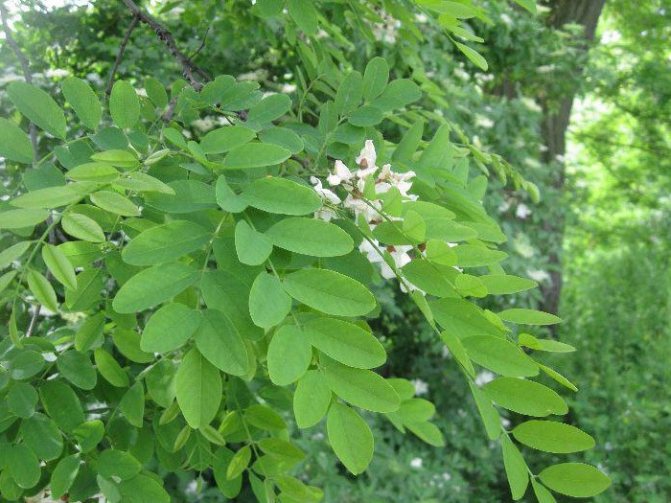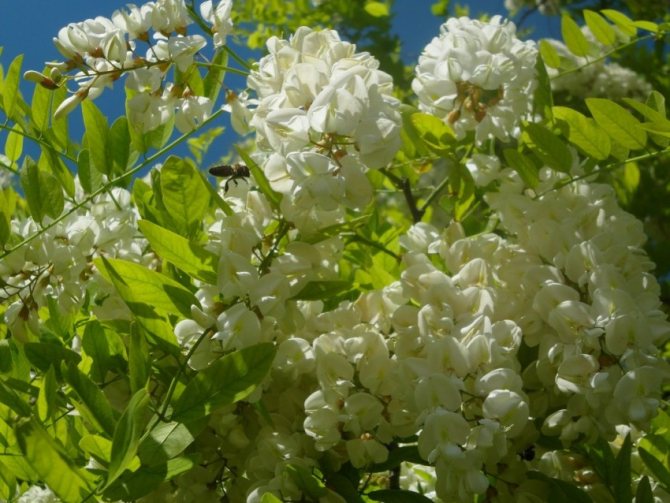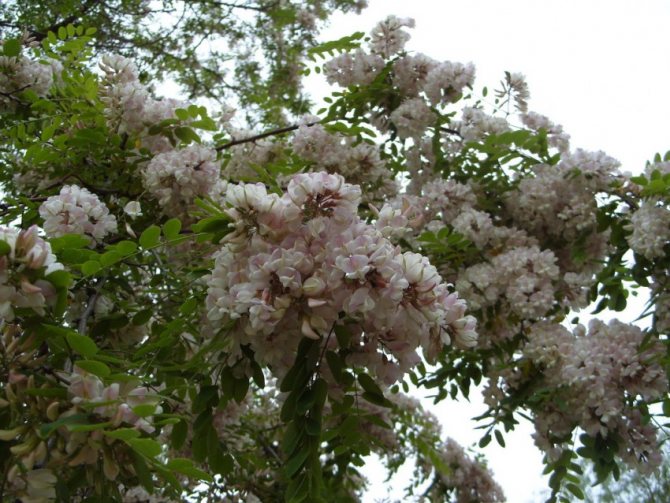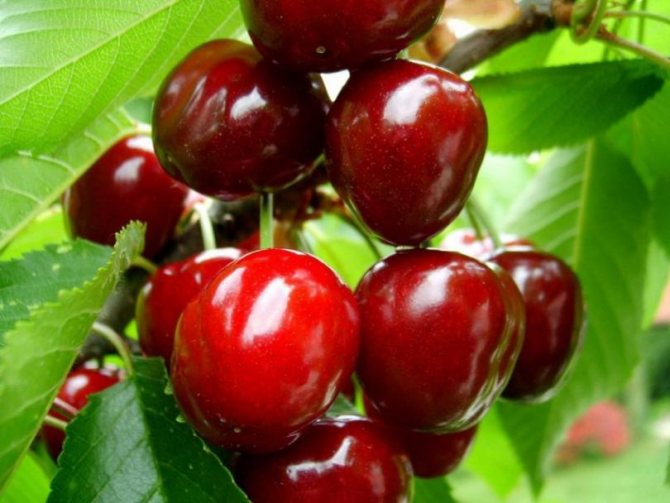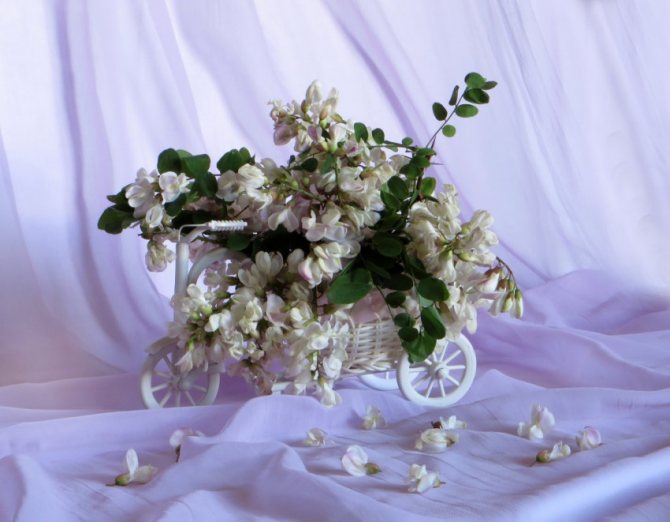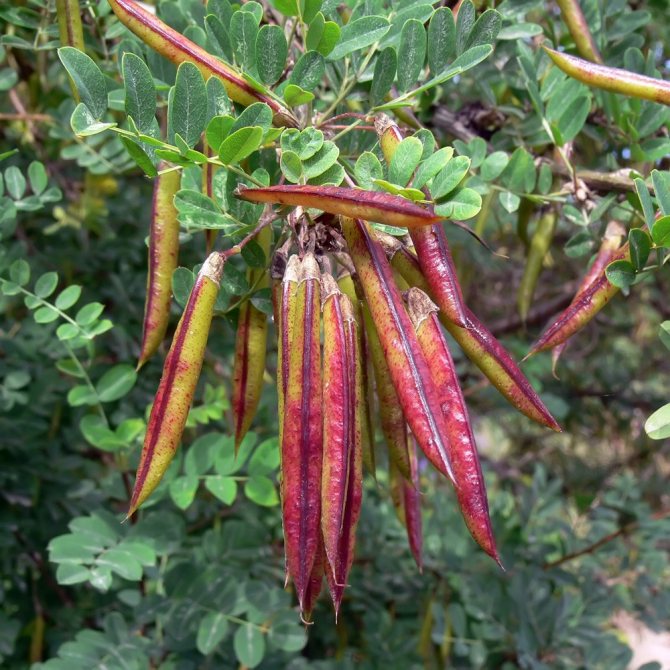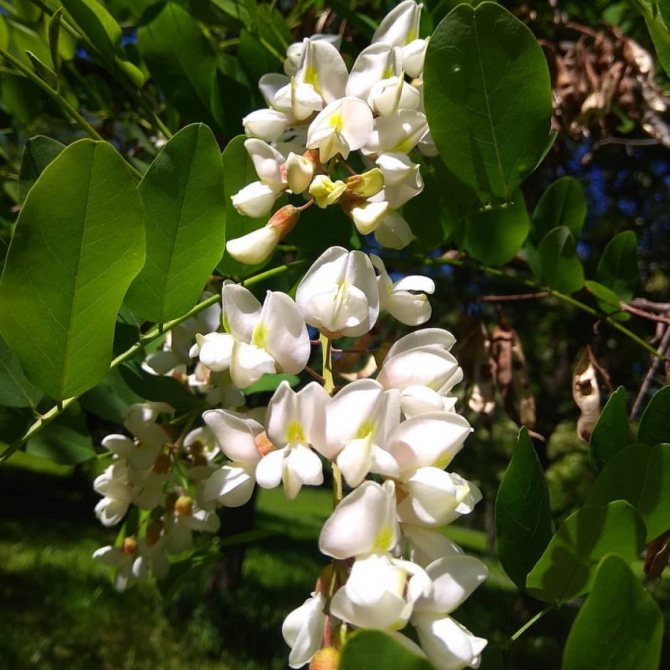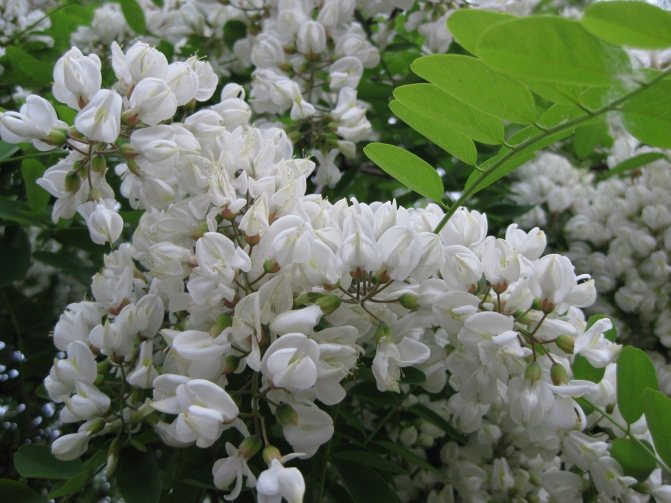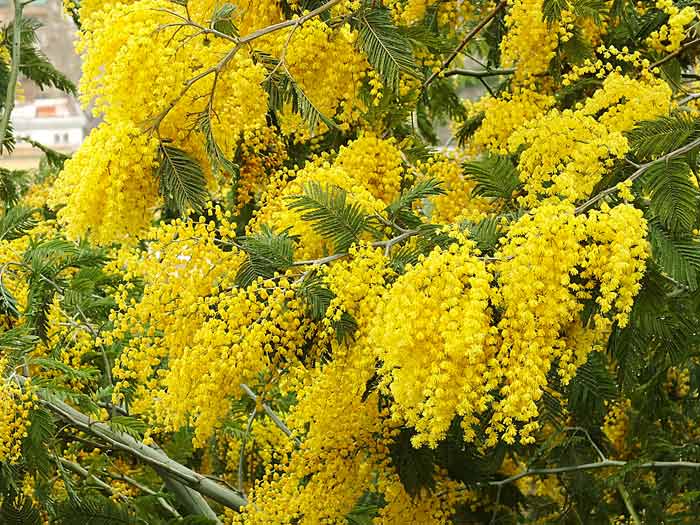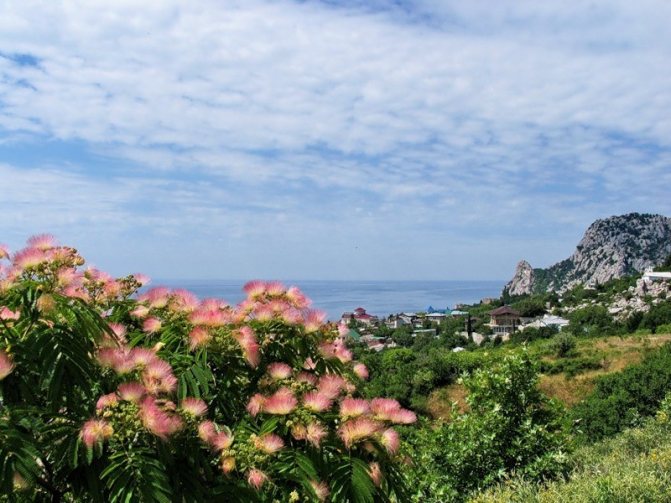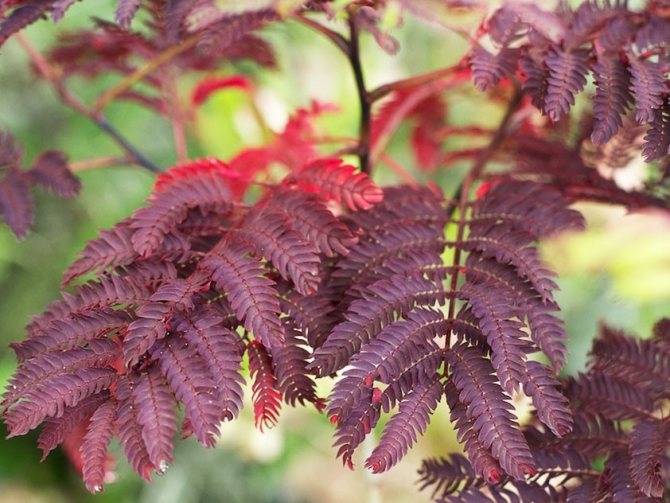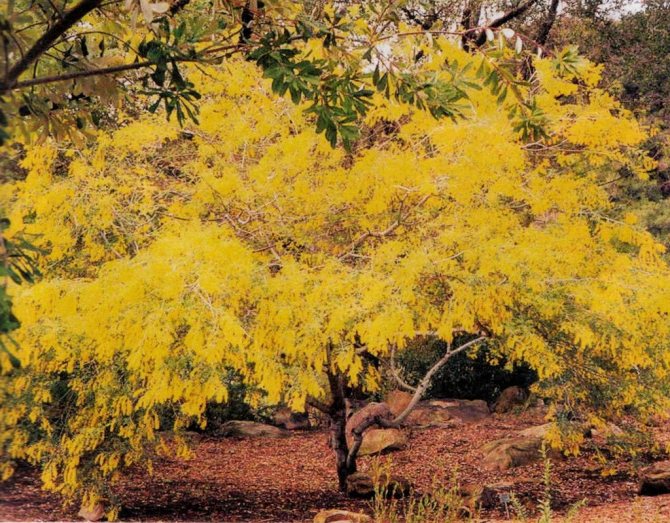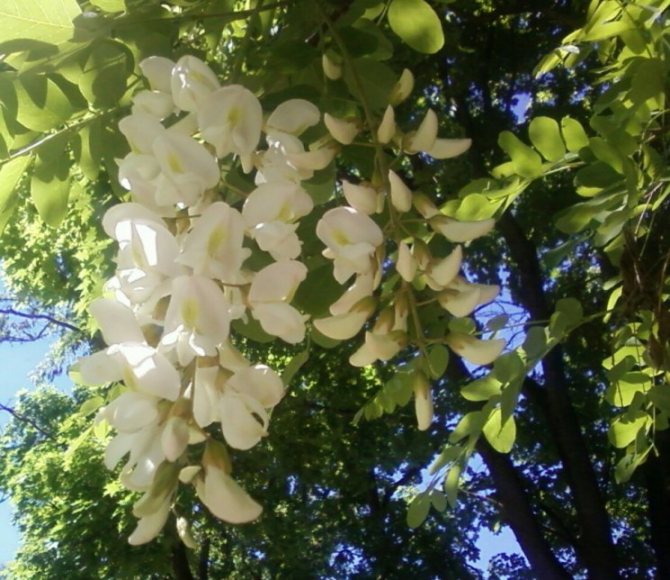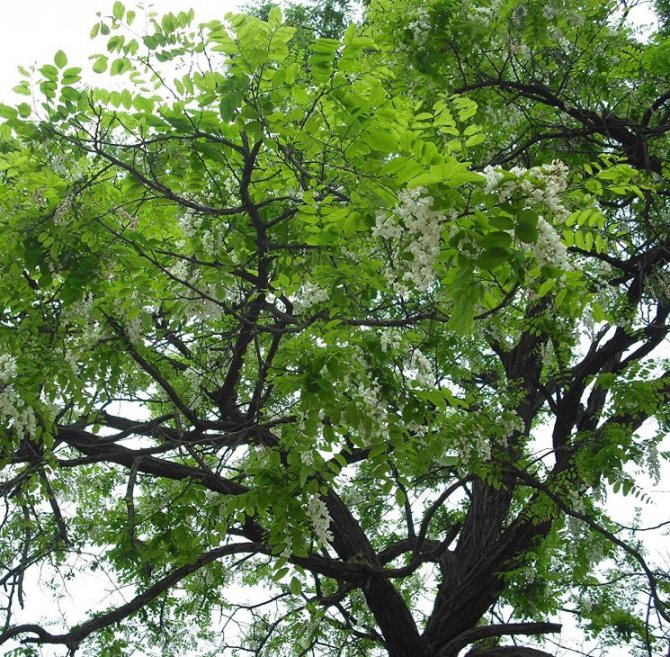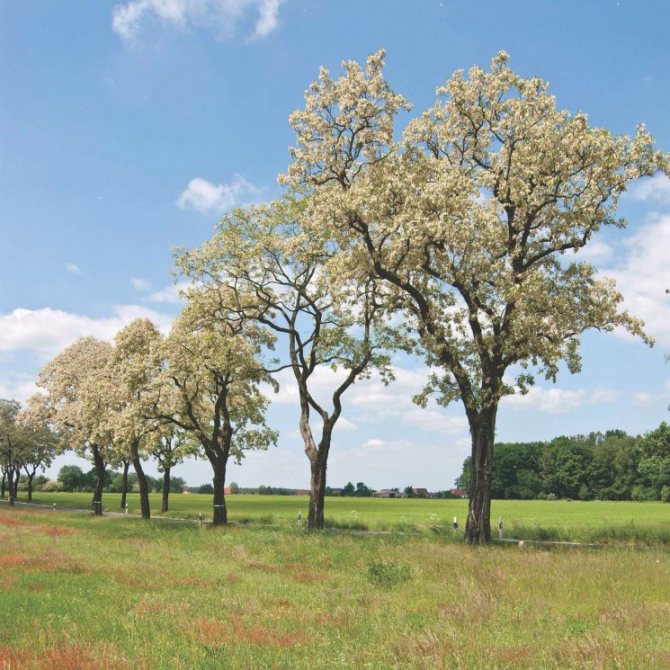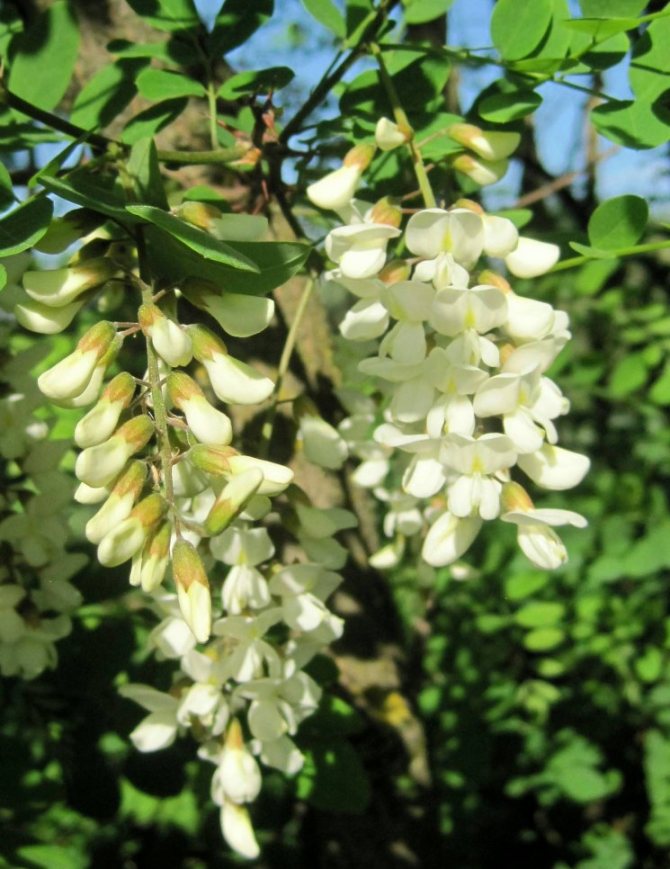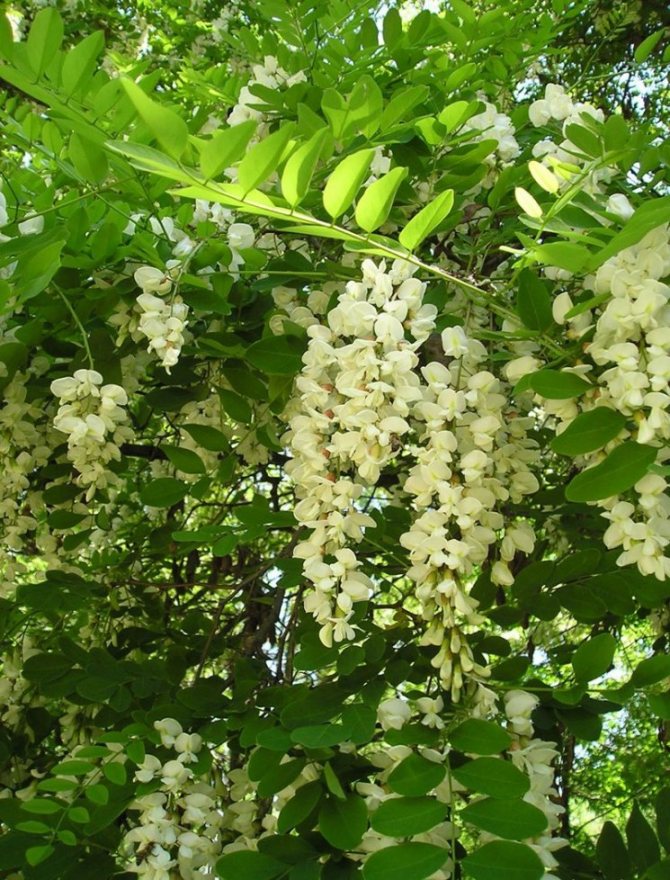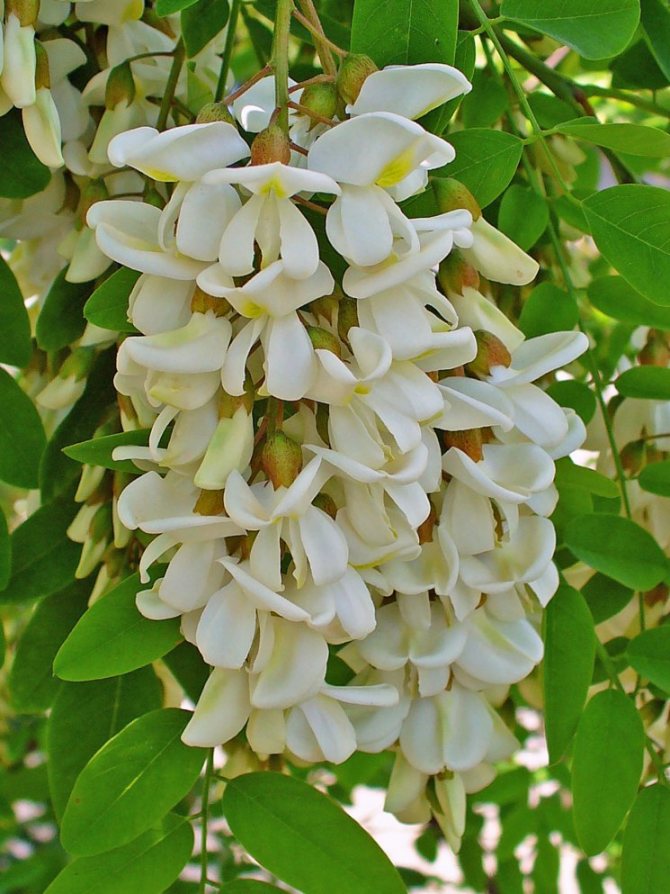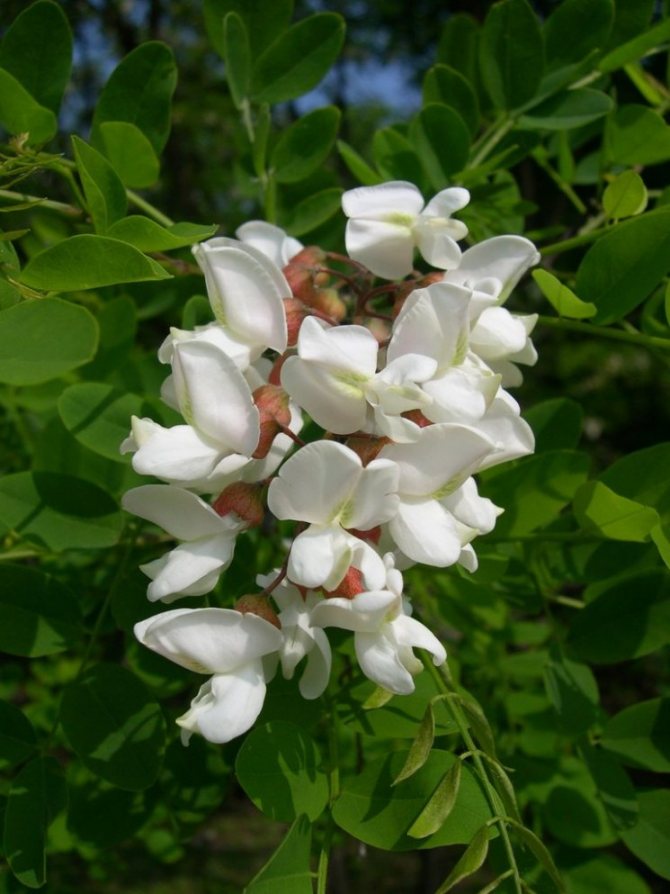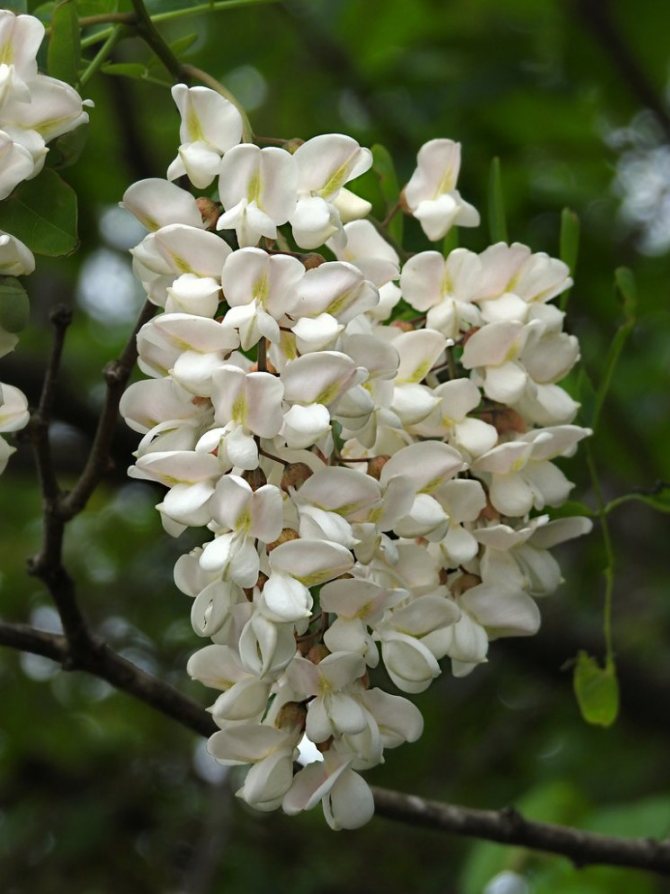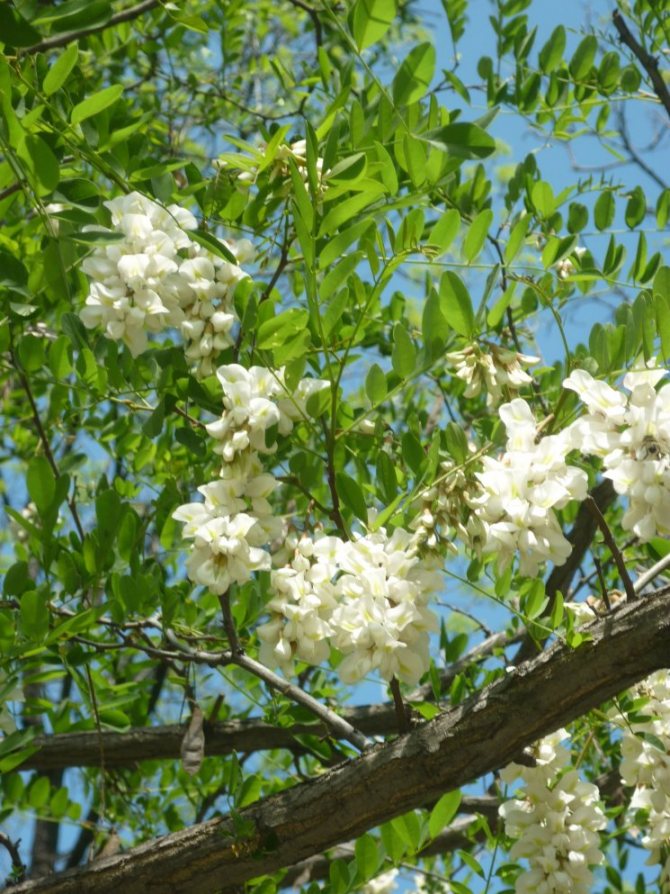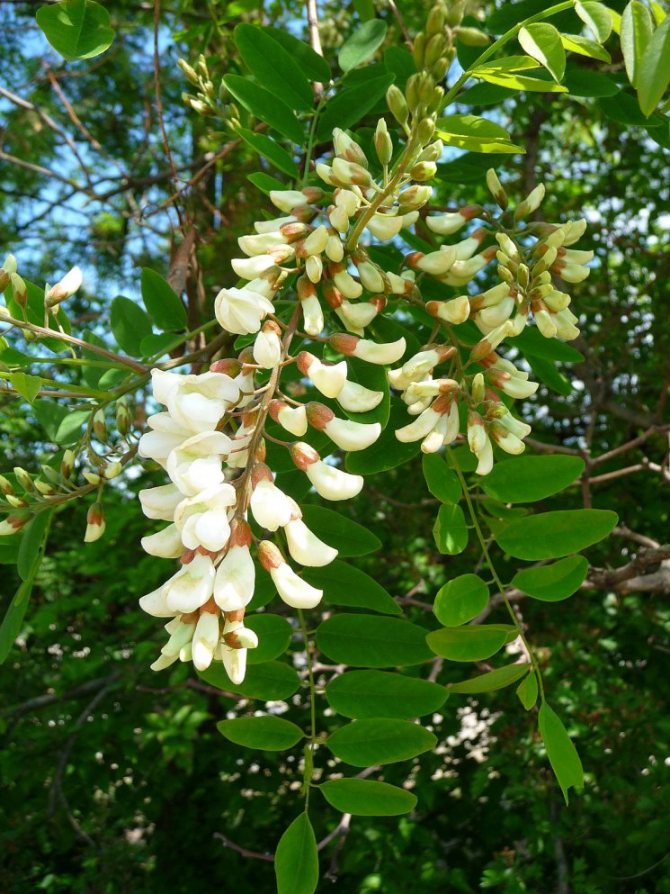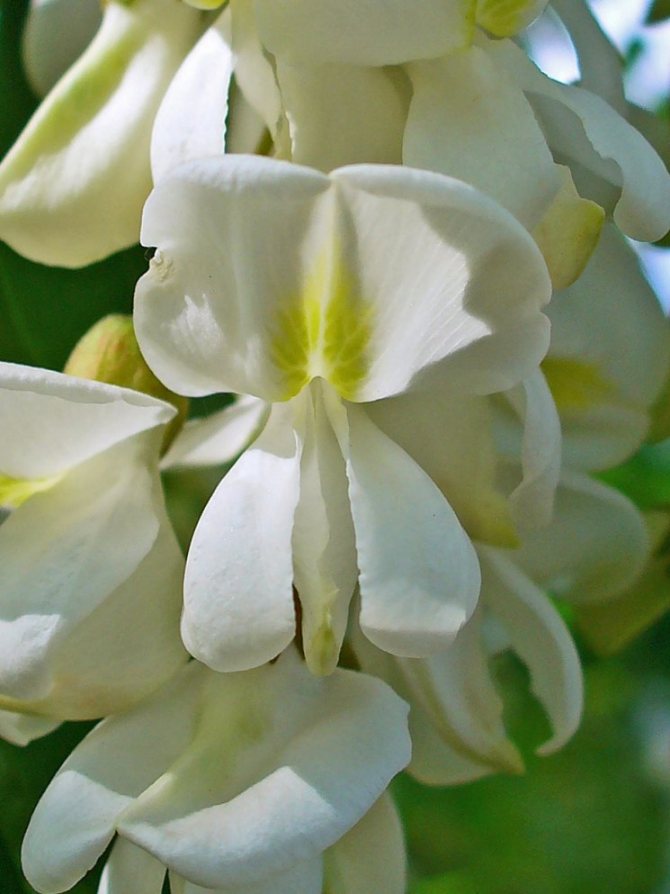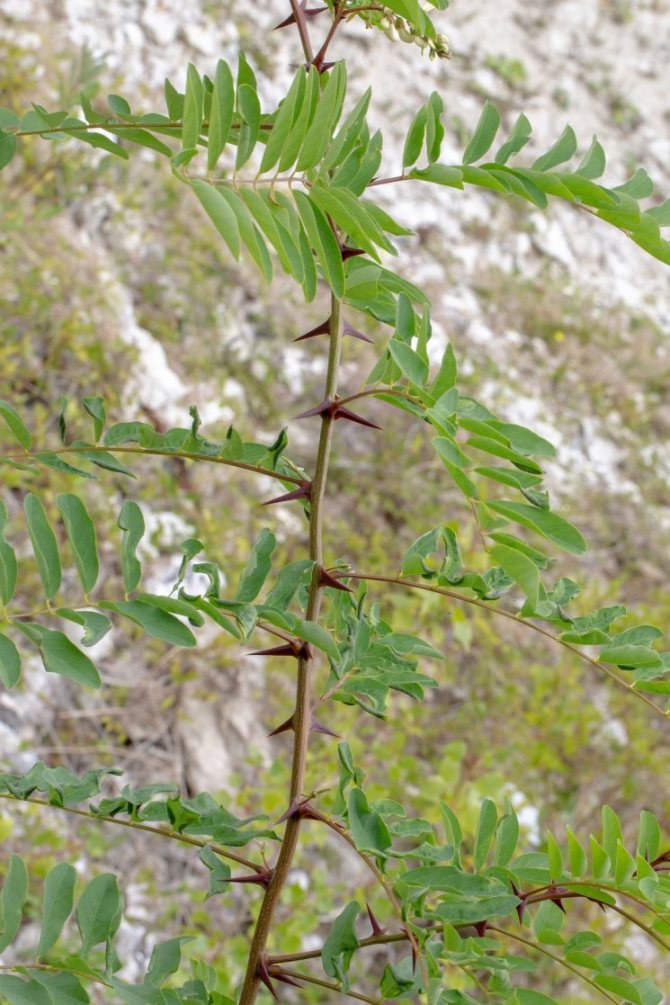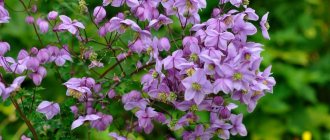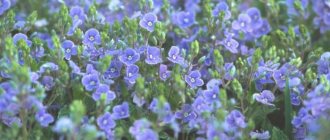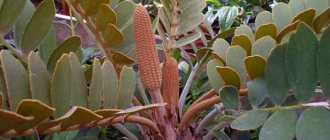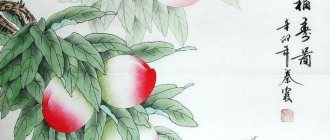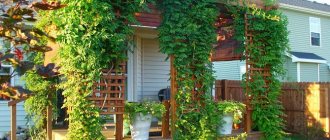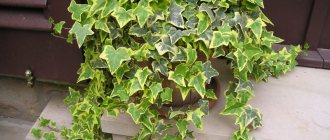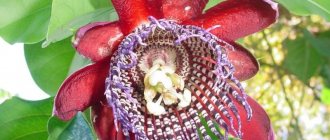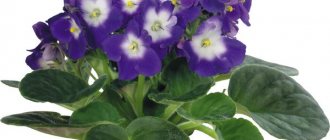Detailed botanical description of the tree
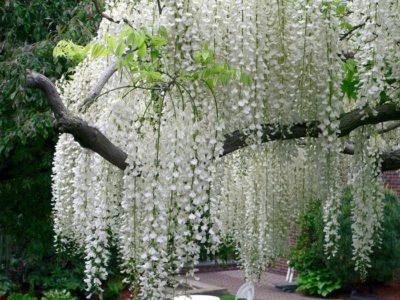
According to the description, this is a beautiful decorative tree with a spreading openwork crown and fragrant white flowers, which are collected in large inflorescences. Its trunk can reach 1 m in diameter, the bark is very thick with longitudinal stripes, the color of the bark varies from brown to dark gray (in young trees, the bark is smooth, light gray).
The leaves of the tree are green, ovoid, opposite each other, reaching a length of 25 cm. Flowering takes place in May - June. When the acacia blooms, within a few days there is a strong release of nectar (good honey plant). In September, the seeds begin to ripen - brown, flat beans.
The root system of the White Acacia is very powerful and well developed, there is a main stem, strong branching occurs in the upper layers of the soil. White Acacia grows very quickly, especially in the first 10 years, in 1 year it can grow 80 cm in height and 30 in width.
Let's take a closer look at all the parts of this beautiful and useful tree:
- Seeds. They are an elongated bean, can be linear, lanceolate or ovoid. Also, the bob can be straight or curved.
- Fetus. It is a flat pod, usually brown in color, inside which there are seeds - beans (5 or 6 pieces).
- Inflorescences. They differ in shape, can be cylindrical or paniculate, capitate-type inflorescences are also found.
- Thorns. In many species of acacia, stipules have transformed into thorns, i.e. spines of white acacia are modified stipules
- Flowers. A huge number of small or large, fragrant, can be heterosexual or bisexual, they are collected in hanging bunches.
Blooming White Acacia is simply mesmerizing. Acacia flowers can be not only white. There are varieties with flowers in yellow, light pink, dark pink, golden and even purple.
Robinia in the landscape
Common or white acacia is one of the common ornamental trees that adorn not only city streets and parks, but also household plots. Lush crown, thick flower cap, heady scent of white acacia make it in demand for urban and suburban landscape. In addition to the decorative functions for which this wonderful tree is grown in the city, it is also an excellent honey plant, which has a purely applied purpose when planting near apiaries and in the countryside, near their houses to attract bees to the territory, which contribute to the pollination of other crops.
The genus Robinia has a huge number of species, among which the following can be found most often in everyday life:
- Robinia hispida is a shrub up to 3 meters high, all shoots of which are covered with reddish hairs. A feature of the species are pink-purple flowers, collected in large clusters. Blooms en masse in late spring, but single inflorescences appear during the summer.
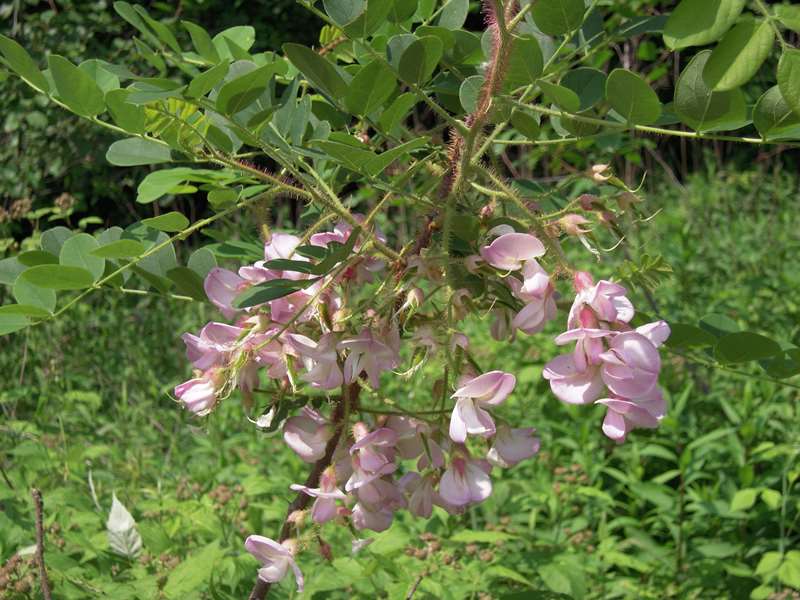

Robinia hispida - Sticky Robinia (Robinia viscosa), it is also called pink acacia - a tree up to 12 meters high, with a beautiful rounded crown. The flowers are purple, collected in a brush.Abundant and long flowering is a decorative feature of the species. Robinia gummy got its name for the numerous hairs that secrete a sticky liquid.
- Robinia pseudoacacia Frisia. A tree up to 10 m high with a beautiful golden crown and large white flowers. It is especially often used for decoration of suburban personal plots.
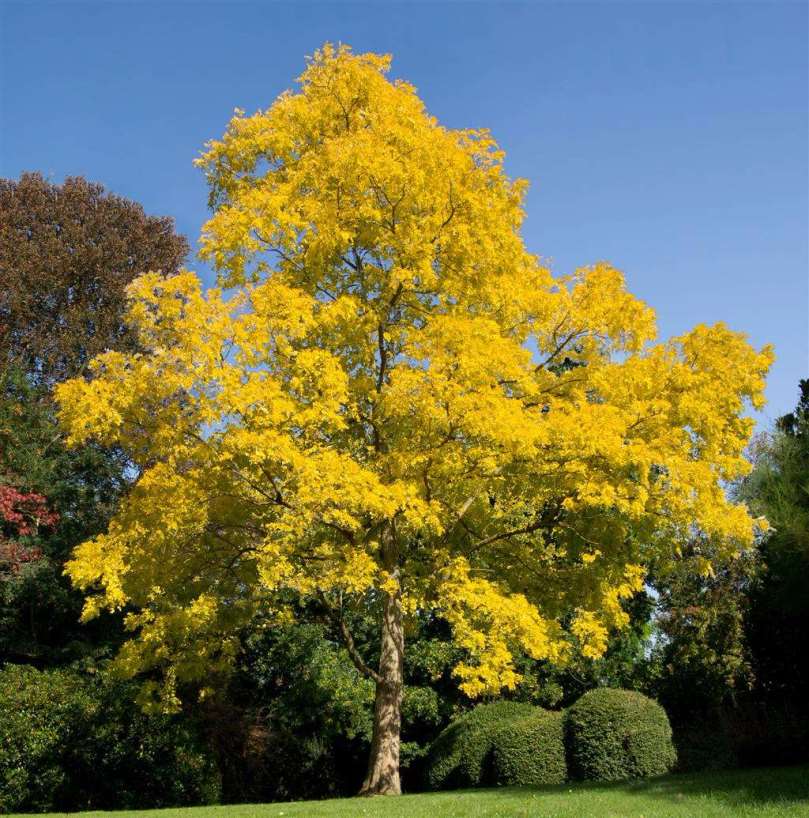

Robinia pseudoacacia Frisia
Robinia tolerates pruning well, it is convenient to create hedges and interesting green compositions from it. In parks and squares, it is used to create shady alleys, decorate the banks of ponds or other artificial reservoirs. A single white acacia tree planted in the garden to create artificial shade looks great.
Unlike many other ornamental trees and shrubs, acacia grows well in hostile urban environments, where it is often planted along city roads, as well as in industrial areas to create a green shield. The benefits of white acacia are also appreciated in green farming: with its help, wind barriers are created, slopes, ravines and slopes of the railway track are strengthened.
History of origin
White acacia is native to North America, and the history of its appearance in Europe is associated with the name of the gardener Vespasian Robin, who served at the court of the French king Louis XIII. He brought the seeds of this wonderful tree in 1635 to Paris. Since the tree grows very quickly, then, accordingly, very soon it could be seen not only in the Royal Garden, but also on the streets of Paris.
Where does white acacia grow in Russia? In Russia, the White Acacia appeared at the beginning of the 19th century. It grows well on the Black Sea coast of the Caucasus and is very common in central Russia.
Acacia honey
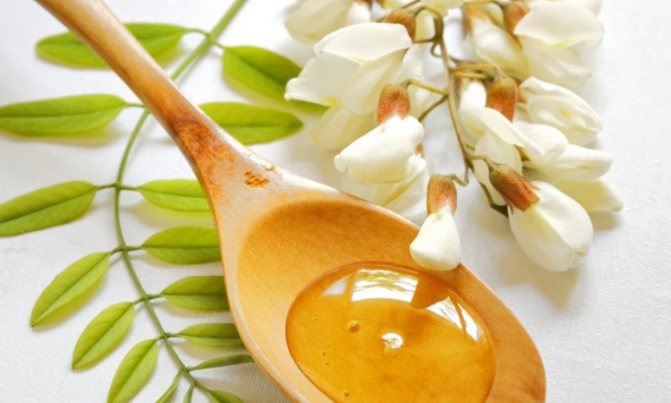

The beneficial properties of acacia honey are recognized all over the world. White acacia belongs to melliferous plants. Acacia honey has a delicate texture and a pleasant light aroma.
In a liquid state, it is almost transparent, and after crystallization (sugaring) it acquires a white color and a fine-grained consistency. Bitterness is not peculiar to honey.
This type of honey is able to remain in a liquid state for a long time. Sugarning is slow due to the high fructose content and the low sucrose content of the honey. The product can retain its transparent viscous consistency for up to 2 years.
Acacia honey is often used for medicinal purposes. It has antimicrobial and anti-inflammatory effects. Useful for gastrointestinal ulcers, gastritis, colds.
This honey does not cause an allergic reaction, which is why it is often used to treat children.
Acacia honey is useful for hypertension and is an important component of diabetic nutrition in diabetes mellitus.
Medicinal properties and contraindications
The medicinal properties of White Acacia are quite successfully used in many countries, while decoctions, tinctures, infusions based on bark, leaves and flowers are used.
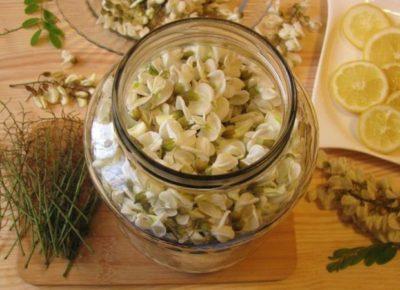

White acacia has the following properties:
- antimicrobial;
- immunomodulating;
- anti-inflammatory;
- pain relievers;
- mucolating;
- wound healing.
It is used for the following diseases:
- joint and rheumatic pain;
- gastritis with increased acidity of the stomach;
- tuberculosis;
- atherosclerosis;
- frequent migraines;
- neuralgia;
- colds;
- skin diseases;
- liver diseases;
- hypoavitaminosis.
Acacia honey increases the body's defenses very well.
IMPORTANT! The seeds and bark of the White Acacia contain toxic substances, so the dosage of the preparations must be strictly observed!
There are a number of contraindications in which, in no case, preparations from White Acacia can be used:
- hypervitaminosis;
- tendency to allergic reactions;
- pregnancy;
- childhood;
- period of breastfeeding.
For medicinal use, acacia flowers are harvested at the very beginning of flowering. (when not all have blossomed), it is best to dry outdoors in the shade.
Photo
Here you can see bunches of decorative white and yellow acacia trees on the trees during the flowering period:
You can also read about the medicinal and beneficial properties of White Acacia here, and here read about honey from this plant and the use of the product.
Subsort of plants: description and photo
White acacia has a considerable number of sub-varieties. The most famous are the following robinies:
New Mexican
The height of the New Mexican Robinia does not exceed 12 m, the flowers are pale pink, odorless.
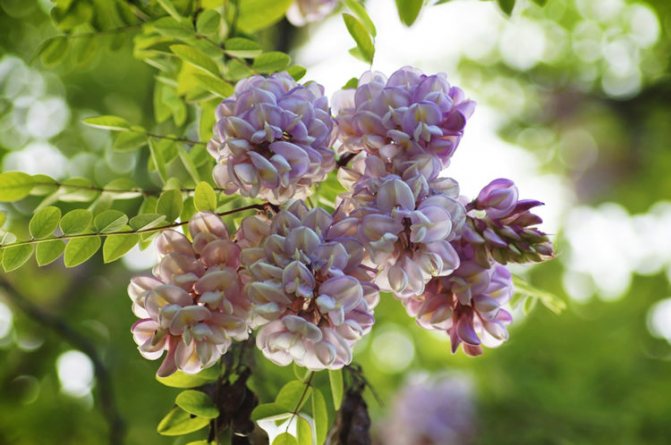

Sticky
A tree with a rounded crown, the name "sticky" got because of the sticky hairs on the leaves, inflorescences and shoots, flowers are pink with a purple tint.
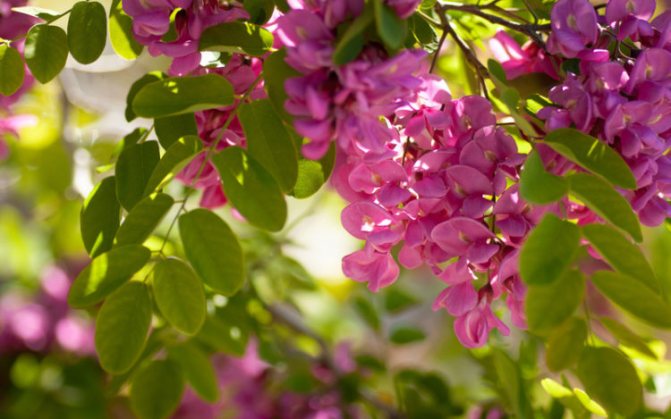

Bristly-haired
Shrub form (does not exceed 3 meters in height), pink flowers; a distinctive feature is the reddish bristles that cover the entire shrub.
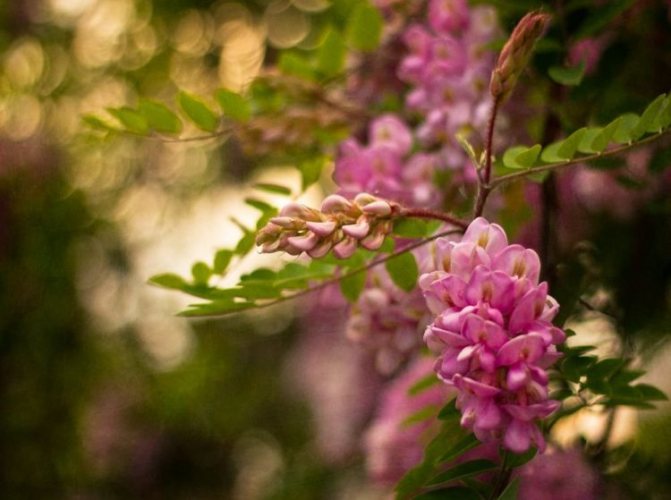

Yellow (Kargana)
The yellow acacia is a low, multi-stemmed shrub (up to 3 m), the bark is gray-green, the flowers are yellow; earlier this tree was popularly called the “pea tree”.
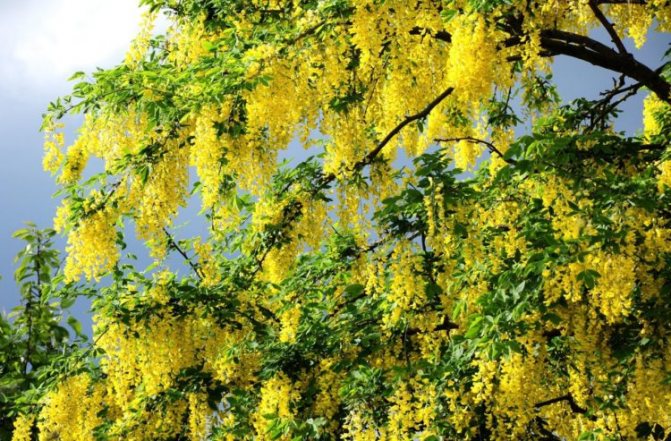

Transplants
Characterized by intensive growth, especially in the first years of life, acacia is transplanted into a wider and deeper container every year. Transplants are carried out after the plant has faded. The soil is prepared from a mixture of sod and leafy soil with humus and sand, which will add nutrients to the composition and increase its air permeability. In the process of transplantation, attention is paid to the condition of the roots, broken or rotten ones must be removed.
Having comfortably placed the plant in a container, it is carefully covered with new soil, the surface is compacted and generously moistened.
Bloom
Usually, the flowering of the White Acacia begins to actively occur at the age of 6, it lasts from the end of May to July. Caring for an acacia before flowering, that is, it turns out, for a young plant, naturally differs from caring for an adult tree. The main points of care before flowering:
- regular watering of young seedlings;
- regular feeding;
- you also need to constantly monitor that the near-trunk circle is clean, remove all weeds;
- you can mulch the soil around the tree with peat or small pebbles;
- it is important for the tree to provide enough sunlight (so that neighboring trees do not shade it).
After flowering, mature trees do not need watering; natural moisture is enough for them.
IMPORTANT! Immediately after flowering, you must remove all dried inflorescences so as not to weaken the tree.
What to do if White Acacia does not bloom? This can happen only in one case - the tree has been badly damaged by groundwater and the roots have begun to rot. In this case, the best option would be to transplant (if it is a young tree) or propagate and plant a new seedling in a suitable place.
Pruning
It is better not to get carried away with acacia pruning and resort to it only when the need... In particular, this procedure is relevant. in early spring: all branches broken after winter are cut down at the base.
Frozen branches will become visible in the summer - they can be removed after flowering.
In crown formation acacia does not need. First, she is beautiful in herself.
Secondly, pruning will provoke the growth of long shoots and shoots, so that this will not be reflected in the appearance in the most favorable way.
Photo
This is what acacia looks like in the fall before preparing for wintering:
Use in landscape design
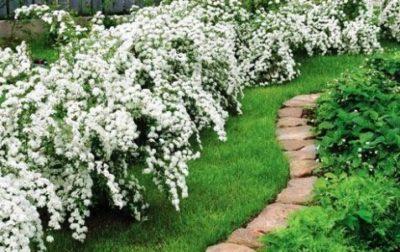

White acacia is quite successfully used by designers for landscaping park areas and gardens, and summer residents in their garden plots create a spectacular acacia hedge. This tree is great for hedges as it grows very quickly., it is formed easily, it is enough to plant young seedlings in the autumn in a checkerboard pattern not far from each other (distance of about 25 cm).
Then you will need to prune in a timely manner and periodically repeat, as a result you get a chic dense green wall.
Creating conditions for growing crops at home
Considering that silver acacia is a very thermophilic plant and is capable of developing exclusively at positive temperatures and an abundance of light, it is cultivated only in the southern regions.
But flower growers all over the world are given the happiness to contemplate this magnificent plant in their own home. Due to the high degree of adaptation, the silver acacia feels great at home, as evidenced by its lush flowering.
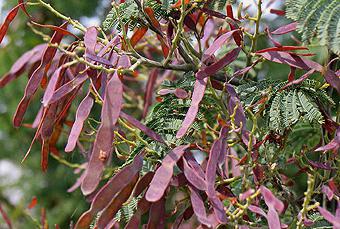

Planting and leaving
White acacia does not require any special care, grows quickly, is easily able to withstand adverse weather conditions, we can say that it is an ideal decorative (and useful) tree for decorating a garden and a house. Let's dwell on the main points of planting and leaving:
- Choosing a landing site. It is better to choose an open place, because the tree is very fond of sunlight, avoid lowlands, as stagnant water can adversely affect the development of the tree.
- What should be the soil. Prefers light soils, but can, in principle, grow on any. The ideal soil for acacia is a mixture of compost with sand and ash.
- Landing:
- to plant a shoot, you need to dig a shallow hole, pour a drainage layer, fix a seedling in it (drive a stake into the hole and attach it to it) and water it well;
- as soon as the seedling takes root, it is imperative to feed it; treatment with epin will also be useful for a young seedling;
- in addition to shoots, you can also plant acacia seeds - the beans are pre-soaked in water (for a day);
- then spread them into shallow grooves in the ground, this can be done in spring or autumn.
- Temperature. The most optimal temperature for a good growth and flowering rate of White Acacia is about 20 - 25 degrees, but this tree can withstand frost up to 35 degrees, if the temperature drops below this mark, the tree will suffer very much, maybe even irrevocably. In summer, the maximum temperature for a tree can be 40 degrees.
- Watering. It is required only for young plants, for adults, additional watering is completely unnecessary, if only during a period of perfect drought.
- Top dressing. Plants respond very well to organic fertilizers, it is useful to apply them in early spring and at the very beginning of flowering, well, if the soil is completely poor, then you can apply them every month.
- Pruning. An adult tree needs pruning, it should be carried out in spring or summer, during pruning, all dry and unnecessary branches (broken) are removed.
- Transfer. If a transplant is necessary, then it is best to carry it out in the spring or at the very end of summer (early autumn) so that the plant takes root well.
How to apply
Funds based on white acacia are used in both folk and traditional medicine. Pharmacies sell medicinal preparations and individual parts of the plant - flowers, leaves, bark. Infusions, decoctions, compresses, lotions are made from this medicinal raw material.
As a medicinal raw material, the plant is used to relieve colds and lower temperatures. The infusion of white acacia flowers has an expectorant effect, so it is often used to treat coughs.
A decoction of the bark and leaves of the plant helps with diseases of the gastrointestinal tract, reduces the acidity of gastric juice and copes with intestinal obstruction. It is often used to treat gallbladder diseases, ulcers, and gastritis.
Funds based on white acacia are used to treat diseases of the genitourinary system.Infusions and decoctions of the plant have an anti-inflammatory and hemostatic effect, they are often used to treat diseases of the female reproductive system.
Alcohol tincture of the plant helps with osteochondrosis, rheumatism and radiculitis. It is used externally in the form of compresses, lotions, rubbing.
Acacia tincture is used as a powerful expectorant that effectively relieves any cough.
Cough tincture
Ingredients:
- White acacia flowers - 10 gr.
- Water - 250 ml.
How to cook: Grind dry flowers and cover with water. Bring to a boil in a water bath. After 5-7 minutes, remove from heat, cover and let it brew for half an hour. Strain the cooled infusion through a sieve.
How to use: Take 1 tablespoon of the infusion every three hours.
Result: The agent liquefies phlegm and removes it from the bronchi. Helps eliminate paroxysmal cough.
As an antipyretic agent, a decoction of white acacia leaves is used. It is used to treat viral diseases and inflammation.
A decoction of the white acacia plant to reduce the temperature
Ingredients:
- White acacia leaves - 30 gr.
- Water - 300 ml.
How to cook: Knead dry leaves with a rolling pin, pour boiling water over them and put on low heat. Simmer for 5-7 minutes, then remove from heat and cool.
How to use: Take 10 ml 3 times a day before meals.
Result: This folk recipe will help you get back on your feet quickly after the first signs of a cold appear. The tool lowers the temperature and helps to cope with the inflammatory process.
For the treatment of gastrointestinal diseases, alcoholic infusion of leaves and a decoction of white acacia bark are often used.
Tincture on a plant white acacia for peptic ulcer disease
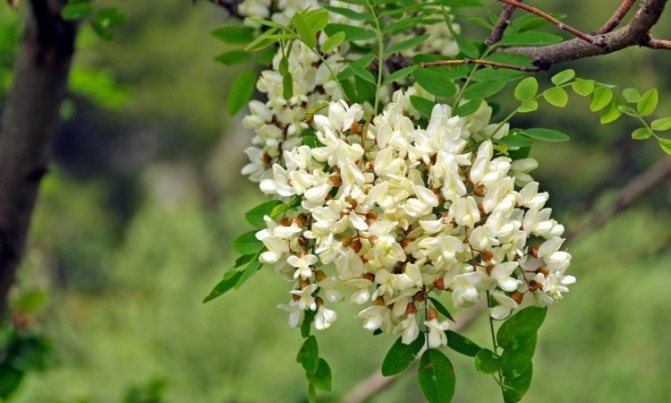

Ingredients:
- White acacia leaves - 20 gr.
- Medical alcohol - 250 ml.
How to cook: Grind dry leaves, place them in a glass jar and cover with alcohol. Close the lid tightly and store in a dark place for 5-7 days. Strain the finished tincture before use.
How to use: Dilute 20 drops of the tincture in a tablespoon of water and take 3 times daily before meals.
Result: It helps relieve pain, reduces inflammation and promotes scarring of stomach and intestinal ulcers.
Decoction for gastritis
Ingredients:
- White acacia bark - 50 gr.
- Water - 500 ml.
How to cook: Crumble the bark, cover it with water and bring to a boil over low heat. Simmer for 10-15 minutes, then remove from heat.
How to use: Take a hot broth, 50 ml half an hour before meals, 3 times a day.
Result: The broth has an analgesic effect and reduces the acidity of gastric juice.
A disease such as osteochondrosis can be treated with alcohol tincture. It is used externally to rub the sore spot.
Tincture for osteochondrosis
Ingredients:
- White acacia flowers - 100 gr.
- Vodka - 500 ml
How to cook: Mash dry acacia flowers, pour them into a glass container and fill them with vodka. Insist in a cool, dark place for 2-3 weeks, shake occasionally. Strain the finished tincture.
How to use: Rub the sore spot with tincture twice a day.
Result: The tool warms up the sore spot and relieves pain in the muscles and joints.
Infusions and decoctions of white acacia effectively cope with diseases of the genitourinary system. They have diuretic, antispasmodic and anti-inflammatory effects.
Infusion from the plant white acacia from cystitis
Ingredients:
- Wheat grass root - 15 gr.
- White acacia flowers - 20 gr.
- Calendula flowers - 15 gr.
- Water - 300 ml.
How to cook: Grind dry ingredients, cover with water and put on low heat. Bring the broth to a boil, stir for 8-10 minutes, then remove from heat.Cover with a lid, wrap with a towel on top and let it brew for an hour. Strain the cooled broth and dilute with boiling water to an initial volume of 300 ml.
How to use: Take 50 ml 3 times a day half an hour before meals.
Result: The infusion soothes the mucous membrane of the bladder and relieves pain.
Reproduction methods
White acacia reproduces, in general, in two ways - by seeds and shoots (root shoots). Most often, the second method is used, because it is more convenient.
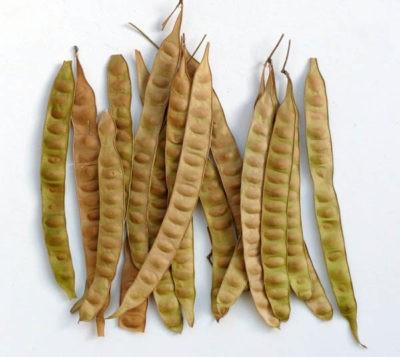

Reproduction by seeds. The seeds (beans) ripen at the end of November, they are harvested and stored in the refrigerator (in a paper bag) until spring. In the spring, sowing is carried out (at a distance of 20 cm from each other) in loose soil in a greenhouse, the required temperature is 22 - 25 degrees. For a year, seedlings grow by about 1 m, next spring they are planted in the ground in a permanent place.- Propagation by root shoots. Since mature trees give a fairly large amount of such growth, you just need to dig out a ready-made shoot and transplant it to a suitable place, everything is very simple. Next, you need to periodically water and fertilize.
We land on the site
When buying acacia seedlings, make sure that the seedling grows in the container in which it is sold.
It's easy to define: if the roots of the plant are visible through the drainage holes, then everything is fine. And the appearance should please: not a thin trunk, even branching, a developed root system. Planting pit should be comparable to the size of the root system. Please note that the roots will first grow deeper, and only then expand. The dense soil must be loosened in advance, drainage up to 20 cm must be poured into the bottom of the pit. Add compost and sand to the excavated soil so that the resulting planting mixture does not become too greasy. Season the mixture with lime materials (crushed limestone, ash or others), mix well with the soil.
After planting, spill the seedlings well, and at first watch the moisture level.
Diseases and pests
REFERENCE! The tree is very resistant to various pests and diseases, only occasionally it can be attacked by sucking parasites: sawfly and false shield.
In this case, the curvature of new shoots can occur, the growth and development of the tree can generally slow down.
To begin with, try to treat the tree with decoctions of plants - hellebore or spotted hemlock, but if things are really bad (the tree is severely affected), then you will have to resort to chemical insecticides and treat with Aktara or Karbofos.
May also harm the tree by aphids and ants, which are very fond of sweet nectar (during flowering), after the end of flowering, you will also have to treat the tree with special preparations.
Silver acacia: methods of treatment, procurement
The bark and gum from the cuts made beforehand are harvested after the end of fruiting - in August-September. Medicinal raw materials should be harvested in dry weather, in the morning, until the sun is too hot.
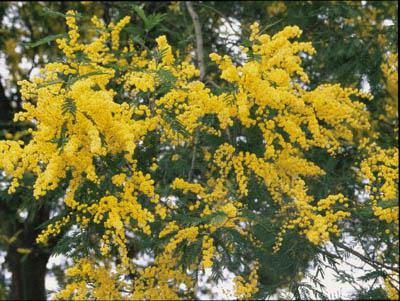

Acacia bark decoctions, which are easy to prepare, are used as a very effective astringent. Acacia oil, used in home cosmetology, is distinguished by its excellent qualities. It is a good antiseptic that relieves skin irritation that occurs both with inaccuracies in the diet, and from any minor mechanical damage. The oil recommended for the care of oily skin perfectly tones and rejuvenates it. In addition, as decoctions and infusions, the oil has a pronounced anti-inflammatory and wound healing effect, therefore, people with problematic and overly sensitive skin need it. The pleasant scent of silver acacia is used in aromatherapy: being a natural antidepressant, it soothes and induces deep sleep.
Planting a cutting
You can buy a seedling ready for planting, it is planted in fertile soil, which can be bought at the store, but add a little sand to it. After that, the silver acacia is planted in pots and watered abundantly.
Plant seedlings can be prepared by yourself. If you decide to propagate your tree or take a shoot for germination from friends, then you must proceed as follows:
- After pruning, strong shoots are selected, the length of which should be at least ten centimeters.
- For eight hours, the cutting should be in a rooting stimulator.
- After that, it is planted in a pot, the soil is well watered.
- A mini-greenhouse is built from a plastic bottle: the bottom is cut off, the cap is removed, the wide part of the bottle is placed over the seedling so that it is completely closed.
- After this procedure, the rooting of the shoot will begin. During the process, it cannot be watered, there will be enough condensation formed in the mini-greenhouse.
If the heating season has begun, then place the pot on the windowsill above the radiator, heating will speed up rooting. It will be possible to remove the greenhouse in three weeks.
Top dressing and watering
The active growth of acacia requires intensive watering with regularity 1-2 times a week; during the dormant period, the plant is watered once every 10 days. Nevertheless, you need to focus on the state of culture. In very hot weather, the frequency of watering is increased, if the need arises, the acacia is sprayed.
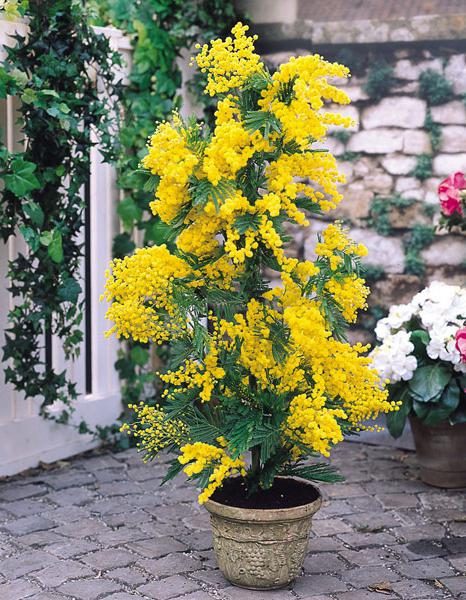

Throughout the entire period of activity, acacia is fed with solutions of complex fertilizers. It reacts well to fertilizers of the peat-humic group. Top dressing is carried out once every 3 weeks. It is not recommended to fertilize the plant during the dormant period.
Acacia - shrub for the garden: description
All the numerous species of acacia belong to the same genus, denoted in Latin "Acacia". However, in gardens, plants are often grown that only resemble acacia, but belong to completely different species, for example, to the genus Robinia. The great similarity of flowers and fruits, leaves has led to the fact that people get used to calling bushes and trees by the wrong name, which sometimes causes serious confusion.
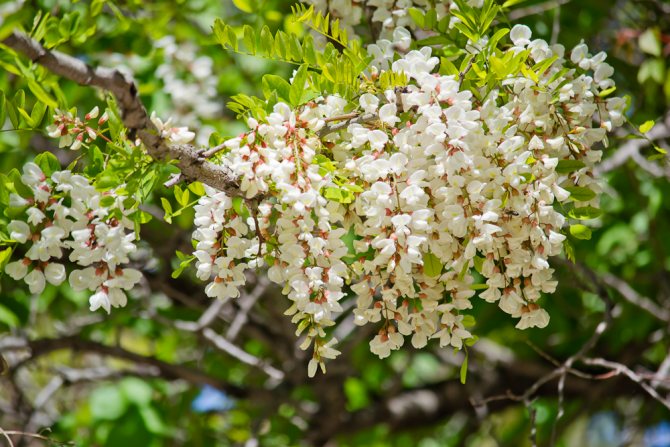

Acacia in bloom
Acacia is a tree or shrub that can grow to a height of 12 m or more. In the garden, as a decoration, shrub forms of small height are often planted: bristly-haired (1-3 m), armed (up to 3 m), tree-like (4 m), magnificent (1.5-4 m), etc. Different species differ in shade and flower size, flowering time, climate and care requirements.
The origin and appearance of the plant
In their natural environment, most of the acacia species grows in Africa, Australia and Asia. In the garden culture, about 50 decorative and flowering species are grown. The variety for the garden is chosen according to indicators: resistance to low temperatures, requirements for the composition of the soil, the need for watering. Different views require a completely different approach.
Most of the acacia varieties are very spreading shrubs or small trees. All have feathery green foliage and their flowers smell good. The leaves on the twigs grow back alternately. On a long petiole there are many small leaves up to 1 cm in length. Many species are spiny with long, sharp spines, sometimes grouped and curved. They most often grow in arid areas. Wood is hard and flexible.
Plant flower descriptions
Flowers for women and men are collected in axillary inflorescences, having the shape of a brush or panicle. Shades are different: white, cream, yellow. The calyx is similar to a bell and consists of five petals, while the tubular corolla consists of 4-5 lobes. In the center of the flower there are many prominent stamens.
For your information! Flowering acacia shrubs are prized for their beauty of flowering and unique aroma. At night, the flowers smell even stronger, luring nocturnal pollinating insects.
The resulting fruit is a long pod, straight or curved, which may or may not open and scatter seeds as it ripens. The seeds are different, but more often they are small and flat.
Features of the
Robinia belongs to the legume family. In its native land - North America, it reaches 30 meters in height, and the trunk diameter can be one and a half meters.
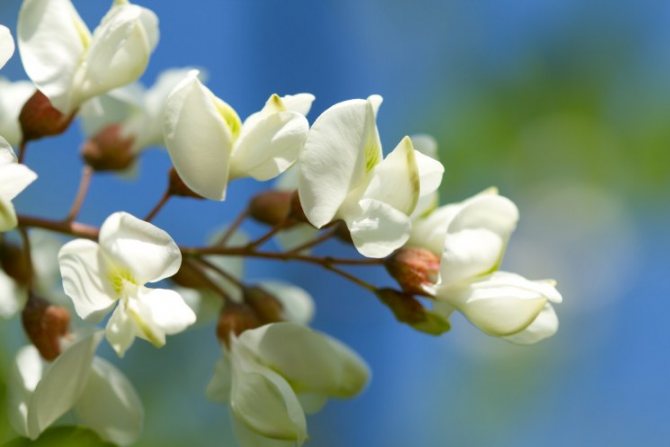

The spreading crown of the "umbrella" allows you to understand that this is a savanna plant, accustomed to the scorching heat. Its resistance to drought and frost has made it popular for planting in parklands. It is the symbol of the city of Odessa.
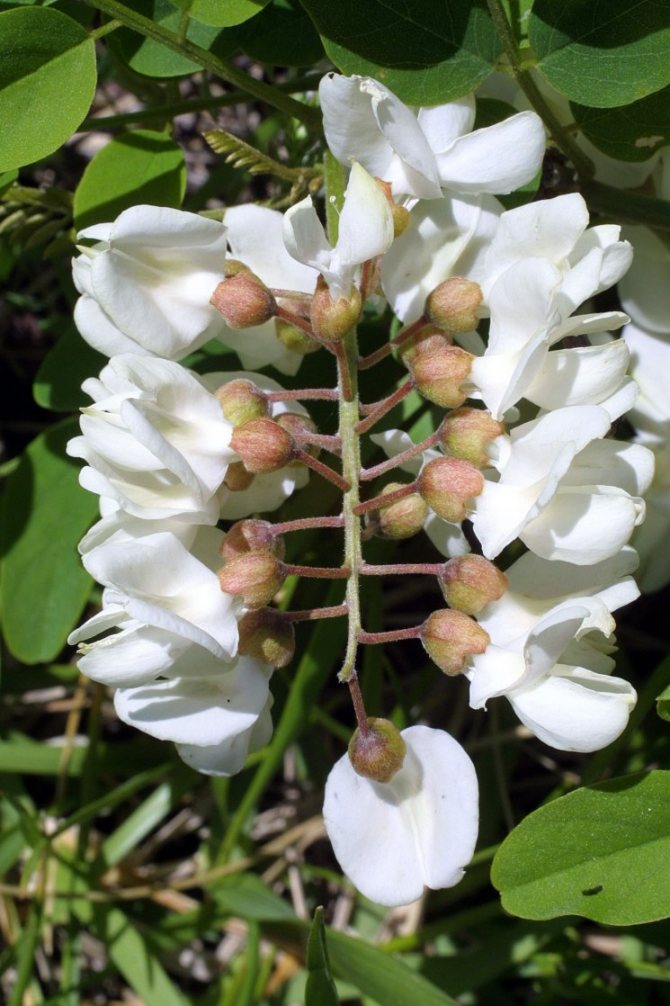

White acacia, a tree that is not afraid of dirty polluted air, industrial emissions, therefore it is actively planted in ecologically unfavorable megacities like Moscow, decorating avenues and enriching the atmosphere with oxygen.
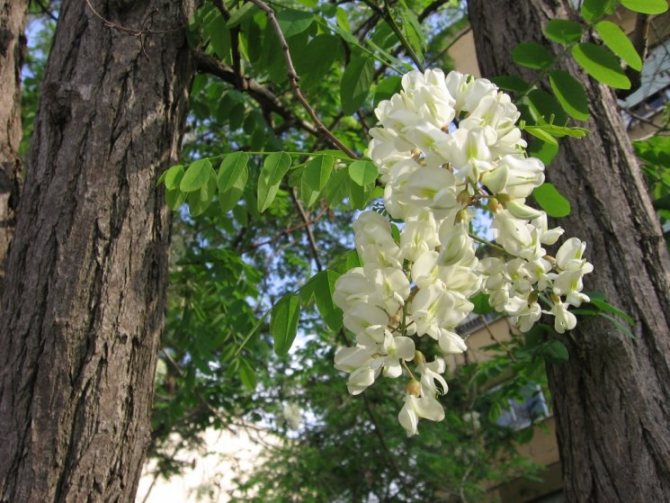

The structure of the cortex is excision by longitudinal grooves. The age can be up to 100 years old. The roots go 20 meters deep, so she is not afraid of the winds.
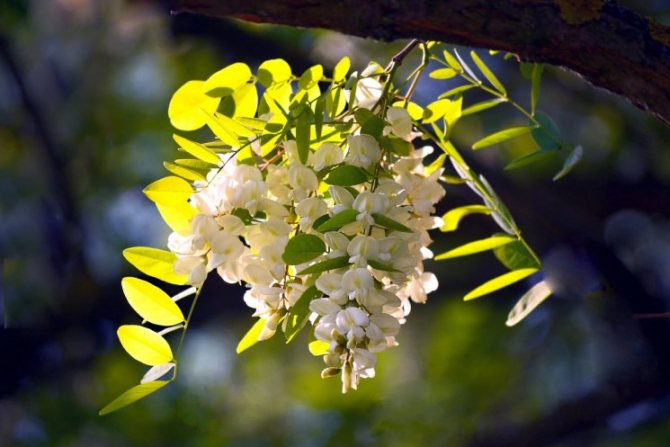

Most of the varieties are armed with thorns, thorns and have poisonous properties - the fruits are contraindicated for livestock.
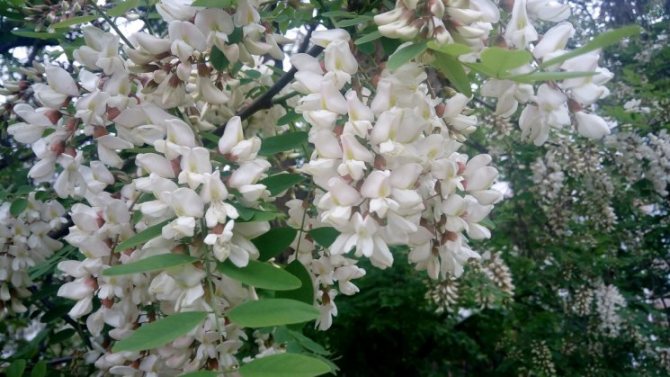

Application
Not a single species of acacia and robinia is included in the state Pharmacopoeia of the Russian Federation, however, white robinia has found application in folk medicine and homeopathy. Infusions and other galenic preparations of flowers and bark of this tree are prescribed for:
- urolithiasis;
- colds;
- osteochondrosis, myositis, joint pain;
- inflammation of the colon, kidneys, bladder and genitals.
In homeopathy, tinctures of fresh robinia bark are used in the treatment of migraines, flatulence, and dyspepsia.


Types and varieties
Viburnum red is a shrub or tree, - description
Among the many varieties of shrub stock in gardens, the following are loved by gardeners.
Acacia Farnesiana
The shrub was zoned for the Black Sea coast of the Caucasus in the 30s. XX century The average height is 2-4 m, but it is able to stretch up to 6 m. The bark is gray-brown, the shoots have a broken shape and barely noticeable pubescence. The pair-pinned leaves are cut into 2-8 twigs, covered with 6-20 gray-green leaves 2.5-5 mm long. The stipules have sharp spines with brown tips.
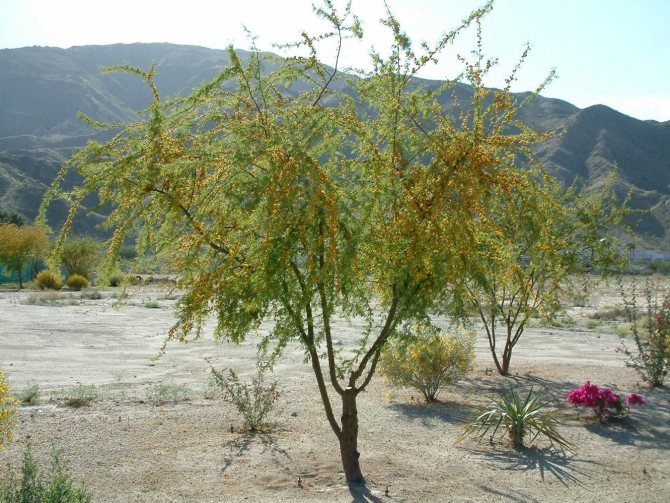

Acacia farnesiana
The variety is renowned for its fragrant blooms. Orange or dark yellow flower 1 cm in diameter. Corollas of five fused petals are pubescent. The fruit is a cylindrical bean, non-opening, with 4-5 smooth dark brown seeds inside. It usually blooms in October-December, but a form that blooms twice a year is grown in a horticultural culture.
Acacia Podalyriifolia
It can grow into a tree up to 5 m tall, but often forms a multi-stemmed spreading bush of a much lower height up to 3 m. The foliage has a beautiful silvery-gray hue. It blooms with numerous fragrant light yellow flowers from January to April.
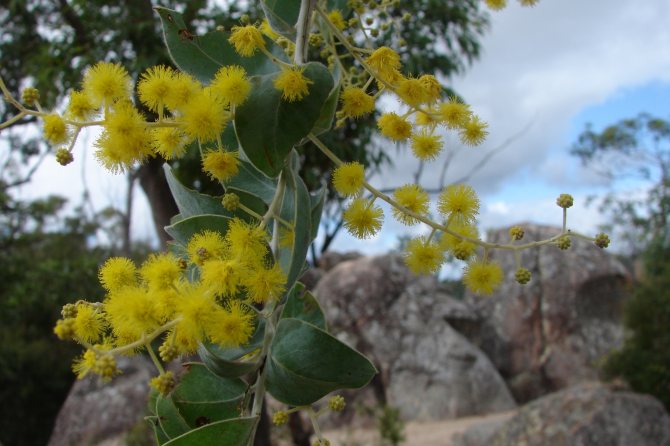

Acacia Podalyriifolia
Note! Can be grown in arid southern regions, where in summer the temperature is kept no higher than 25 ° C, and in winter it does not drop below 10 ° C. The plant is suitable for indoor cultivation in bonsai form.
Gorgeous acacia (Acacia Spectabilis)
Shrub species 1.5-4 m high. Blooms from July to November. The feathery foliage has a greenish-silvery hue. Fruits are large pods up to 17 cm long and up to 19 mm wide.
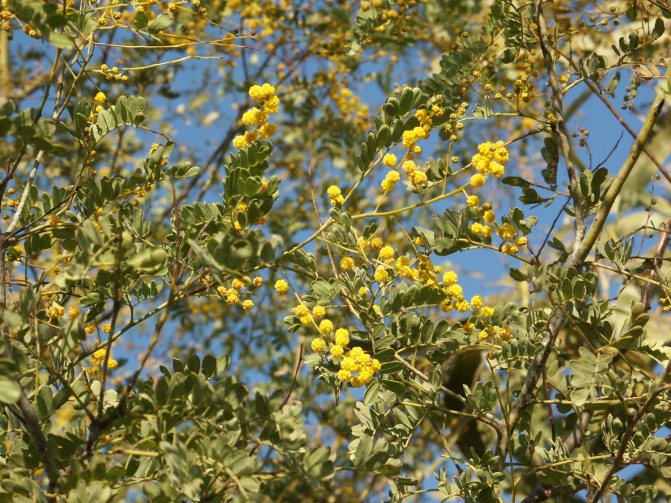

Acacia Spectabilis
The flowers have an intense yellow color and a pleasant, recognizable aroma. Growing conditions - the absence of frosty winters. The variety prefers to lower the temperature in the winter season to at least 8 ° C, and in summer it can withstand heat up to 35 ° C and prolonged drought.
Red acacia (Acacia Oxycedrus)
The shrub got its name for its beauty, but not the shade of flowers. Bushes grow up to 2 m in height. Flower heads have a pale yellow or more saturated shade, they are collected in groups of up to 3 pieces.Bloom lasts from July to October.
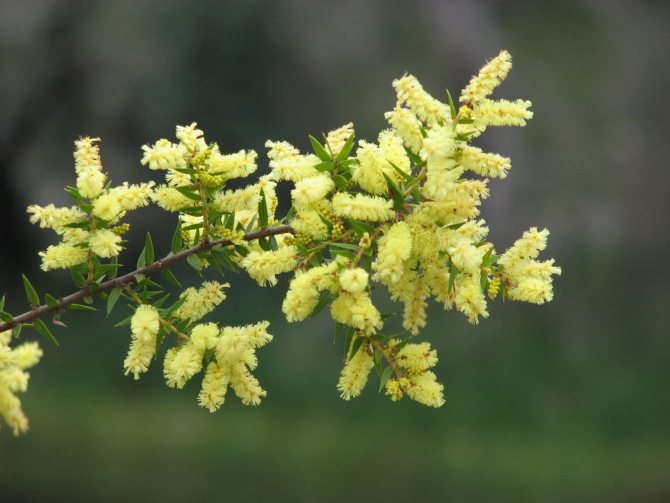

Acacia Oxycedrus
Like most shrub acacias, it does not tolerate even short-term frosts, but it can do without rain and watering for a long time, since the root system is very powerful, it goes to a great depth.
Yellow acacia (shrub)
The exact name is tree caragana (Caragána Arboréscens), that is, it has nothing to do with the genus Acacia. In Russia, it also bears the second popular name - pea plant. The deciduous shrub consists of many trunks up to 15 cm thick. It reaches a height of 6 m. The spreading crown reaches 5 m in diameter.
For your information! In one place it can grow up to 60 years.
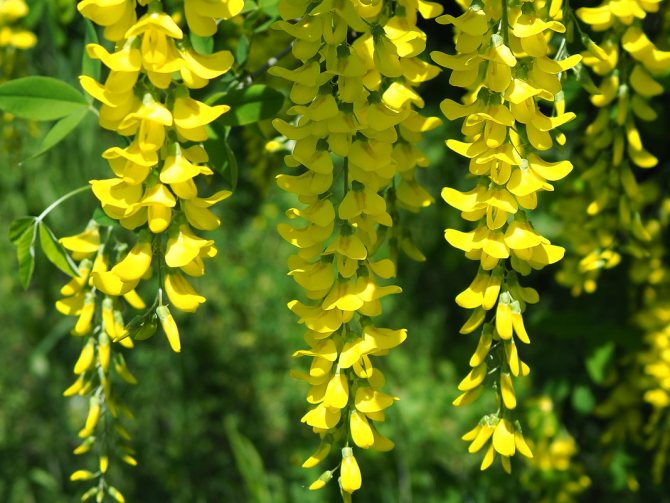

Caragána Arboréscens
Crown formation
All representatives of the legume family grow very quickly, and silver acacia is no exception. Growing and caring, especially high-quality ones, give tangible results: during the spring-summer period, it gives a significant increase. To avoid thickening and giving a beautiful shape to the crown, pruning of the plant is necessary. I must say that acacia tolerates this procedure well. The thickening of the crown is extremely harmful. The sun's rays do not penetrate into the overgrown areas of the crown, flowering on them is noticeably reduced. At the same time, the risk of the occurrence of various pathologies increases.
Therefore, after flowering, the plant is examined, weak branches growing inside the crown are cut out. Forming the required volume, the shoots are shortened, thereby increasing the decorative effect of the culture, at the same time sanitizing it.
A decorative and flowering culture does not give many worries compared to the joy that silver acacia fills your home. Growing it does not involve a lot of time and effort, but it gives you great pleasure.
Collection, procurement and storage
The source of the main medicinal raw material is the flowering acacia. The buds that have begun to bloom are plucked from the branches, laid out on a tarp and dried either under a canopy in the shade, or in dryers at a maximum temperature of 50 ° C.
Robinia bark and leaves can be harvested from April to September. They must be dried with a thin layer and periodically stirred up, preventing blackening, decay and the appearance of mold. When organizing work, the toxicity of the plant bark is taken into account: procurers are supplied with personal protective equipment, pregnant and lactating women are not allowed to work. Robinia raw materials are stored in cardboard boxes or cloth bags for no more than three years. The container with the bark of the plant is marked with the mark "Poisonous!"
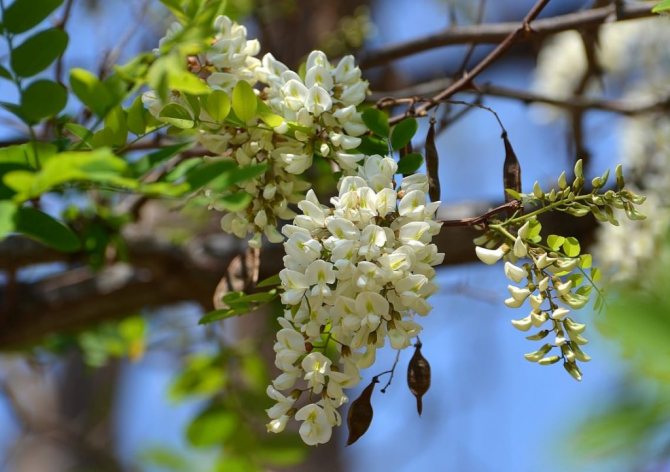

Possible problems and difficulties
The main problems that can arise when growing acacia are as follows:
- Frosting of seedlings... In severe winters, young acacia seedlings can freeze up to the root collar. If the root system is preserved, the plant recovers quickly. Every year, as the acacia grows, its frost resistance increases.
- Oversupply of fertilizers... An excess of nitrogen fertilizers is fraught with the appearance of very long shoots - up to 120 cm in length. They need to be shortened to 40 cm at the end of summer.
- Diseases and pests... It should be noted that acacia is very resistant to diseases and pests. In the steppe zone, acacia can occasionally be affected by sawflies and scale insects. A measure to combat them is treatment with drugs such as Karbofos, Commander, Aktara, etc.
So, following simple rules and recommendations, you can grow white acacia. Its lush snow-white bloom will not leave anyone indifferent. And the healing properties of acacia will help to cope with many ailments and maintain health for many years.
If you find an error, please select a piece of text and press Ctrl + Enter.
Long-leaved
Long-leaved acacia is a tree with a height of 8-10 m, a characteristic feature of this species is intensive growth - in just 5 years the plant reaches a certain height and then grows only in breadth.Leaves of long-leaved acacia deep green, elongated narrow shape with a pointed end. Small pale yellow flowers form a standing fragrant raceme.
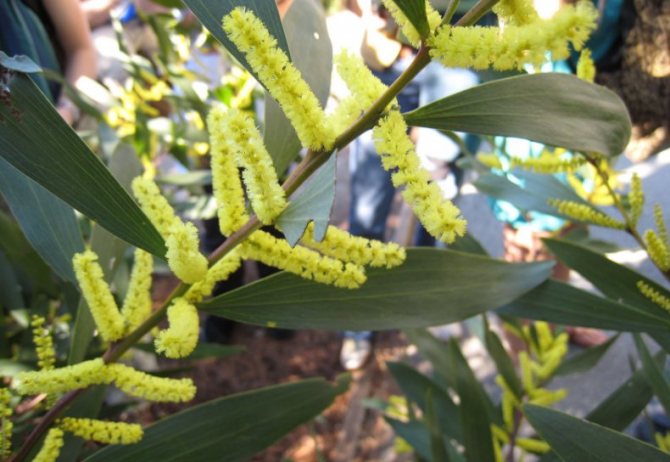

This species is common in Australia and in some areas of the United States. Flowers and seed pods in some countries are eaten and also used to obtain dyes.
Source of healthy foods
The plant has established itself as an excellent honey plant. Bees collect 7 kg from one specimen, and 1500 kg of honey from a hectare. It has a greenish-yellow hue, transparent with a pleasant taste and aroma, does not become sugar-coated for a long time, despite long-term storage, and is saturated with medicinal substances.
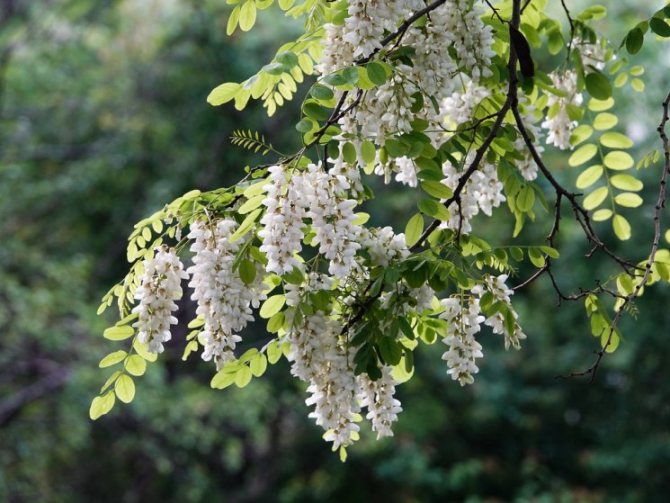

Flowers, seeds are used to make perfumes, and blue paint is prepared from the leaves. Hardwood is used by carpenters, giving in to polish and not changing color from the sun's rays. Acacia parquet is better in quality than oak.
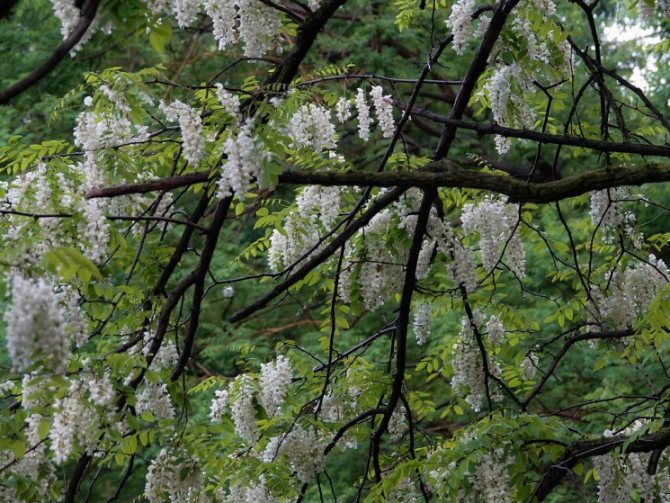

Armed
Armed acacia, or paradoxical, is a compact, densely branching shrub 1 - 3 m high. It is abundantly covered with rich green phyllodia (an overgrown wide petiole that replaces the leaf plate for the plant) up to 25 mm long. The growth bud has a thorn - a modified stipule - this is the reason that this type of acacia was named "armed".
